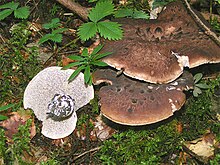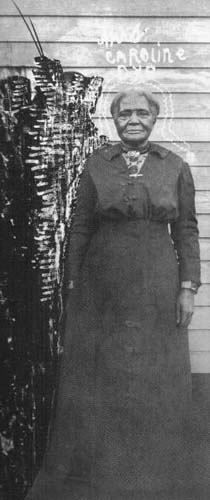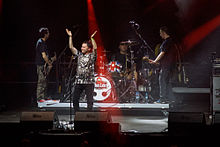테레포랄레스
Thelephorales| 테레포랄레스 | |
|---|---|
 | |
| 사코돈 임브리카투스 | |
| 과학적 분류 | |
| 킹덤: | 곰팡이 |
| 구분: | 바시디오미코타 |
| 클래스: | 아가리코미케스목 |
| 하위 클래스: | 인서테아 세디스 |
| 순서: | 테레포랄레스 코너 ex Oberw. (1976년) |
| 가족들 | |
테레포랄레스는 아가리코미케테스 계급의 곰팡이 순서다.순서는 피질균과 수성균류, 그리고 몇몇 다종류, 쇄골균류를 포함한다.테레포랄에 있는 대부분의 곰팡이는 외관절염이다.사코돈 임브리카투스가 식용 및 상업적으로 판매되고 있는 반면, 공예 염색에 사용되는 종은 몇 가지나 된다.
분류학
역사
1968년 E.J.H.코너 옆을 지날 때 "테레포랄레스"를 언급했지만, 독일의 미생물학자 프란츠 오버윙클러가 처음으로 테레포라과와 뱅커과 등을 아우르는 것으로 묘사한 1976년이 되어서야 공식적으로 그 순서가 발표되었다.[1]원래 착상된 바와 같이, 그 순서 내의 종들은 다양한 기저부위(과일체) 형태를 가지고 있었지만, 특히 기저부위(basisiodospore) 모양의 유사성(대부분의 가시가 돋아나고, 종종 로베드 포자가 돋아나는 것)과 유사성(basiidiocarp)의 유사성 등 여러 가지 공통점을 가지고 있었다.ue에서 알칼리와의 녹색 반응.[2]
현재 상태
분자 연구는 DNA 염기서열의 피복재 분석에 기초하여 테레포랄레스의 형태학적 개념을 지지해 왔으며, 이는 그 순서가 다포랄레스에 가까운 아가리코미케테스 내에서 구별되는 그룹을 형성한다는 것을 보여준다.[3][4][5]
분포 및 서식지
질서 안에 있는 모든 곰팡이는 외관절염으로 살아 있는 나무의 뿌리와 상호 유익한 관계를 형성한다.[3]테레포랄의 분포는 국제적이다.2008년 추산에 따르면, 그 주문은 18개의 제네라와 250종 이상의 전 세계 종을 포함하고 있다.[6]
경제적 중요성
사코돈 임브리카투스(Sarcodon Imbricatus)는 일부 국가의 현지 시장을 위해 수집된 식용 종으로, 중국에서 상업적으로 수집되어 건조제품으로 수출된다.[7]폴리오젤러스 멀티플렉스도 먹을 수 있고 북미에서 판매하기 위해 수집된다.[8]테레포랄레스의 여러 종은 북아메리카의 하이드넬룸 케루움,[9] 스칸디나비아의 사르코돈 스콰모수스,[10] 스코틀랜드의 테레포라 팜타 등 현대 공예가들에 의해 양모를 염색하는데 사용되었다.[11]
참조
- ^ Corner EJH. (1968). "A monograph of Thelephora". Beihefte zur Nova Hedwigia. 27: 1–110.
- ^ Stalpers JA. (1993). "The Aphyllophoraceous fungi I. Keys to the species of the Thelephorales". Studies in Mycology. 35: 1–168. http://www.cbs.knaw.nl/publications/1035/content/txt_035.htm
- ^ a b Hibbett DS. (2006). "A phylogenetic overview of the Agaricomycotina". Mycologia. 98 (6): 917–925. doi:10.3852/mycologia.98.6.917. PMID 17486968. "Archived copy" (PDF). Archived from the original (PDF) on 2011-07-06. Retrieved 2010-11-01.
{{cite web}}: CS1 maint: 타이틀로 보관된 사본(링크) - ^ Hibbett DS, et al. (2007). "A higher level phylogenetic classification of the Fungi". Mycological Research. 111 (5): 509–547. CiteSeerX 10.1.1.626.9582. doi:10.1016/j.mycres.2007.03.004. PMID 17572334.
- ^ Matheny PB, et al. (2007). "Contributions of rpb2 and tef1 to the phylogeny of mushrooms and allies (Basidiomycota, Fungi)". Molecular Phylogenetics and Evolution. 43 (2): 430–451. doi:10.1016/j.ympev.2006.08.024. PMID 17081773.
- ^ Kirk PM, Cannon PF, Minter DW, Stalpers JA (2008). Dictionary of the Fungi (10th ed.). Wallingford: CABI. pp. 12–13. ISBN 978-0-85199-826-8.
- ^ "Archived copy". Archived from the original on 2011-07-07. Retrieved 2010-11-01.
{{cite web}}: CS1 maint: 타이틀로 보관된 사본(링크) - ^ Berch SM, Cocksedge W (2003). Commercially important wild mushrooms and fungi of British Columbia: what the buyers are buying. Technical Report 006 (PDF). Victoria, British Columbia: British Columbia Ministry of Forests Science Program. pp. 1, 5. ISBN 978-0-7726-4932-4.
- ^ 2003년 8월 톰 볼크의 이달 곰팡이 http://botit.botany.wisc.edu/toms_fungi/aug2003.html
- ^ Johannesson H, Ryman S, Lundmark H, Danell E (1999). "Sarcodon imbricatus and S. squamosus — two confused species". Mycological Research. 103 (11): 1447–1452. doi:10.1017/S0953756299008709. "Archived copy" (PDF). Archived from the original (PDF) on 2007-08-04. Retrieved 2010-11-01.
{{cite web}}: CS1 maint: 타이틀로 보관된 사본(링크) - ^ http:///1968.62.62.38/192a/192/dyesb.htm#1928[데드링크]





